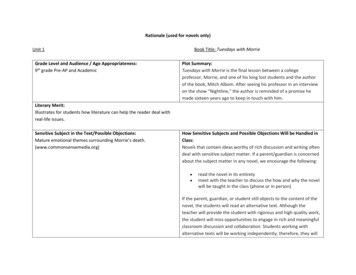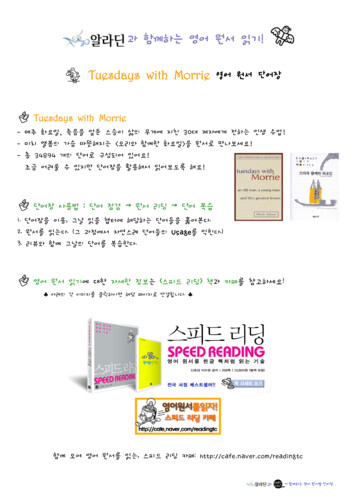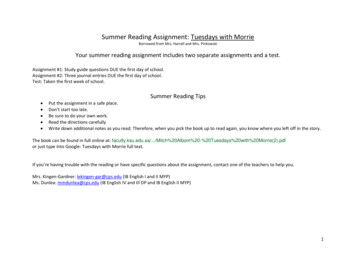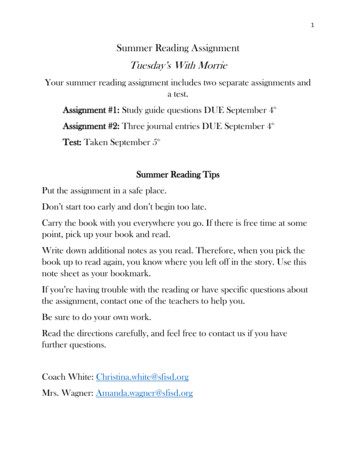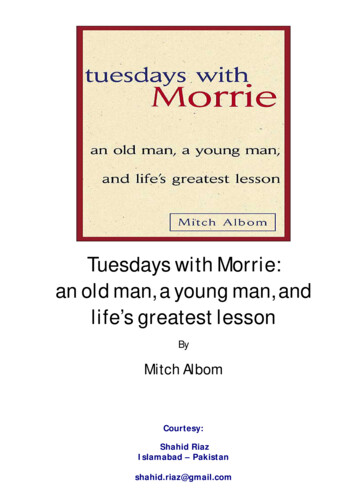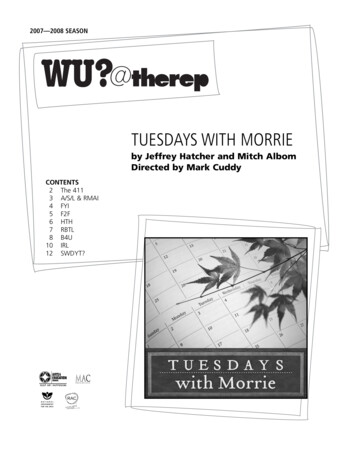
Transcription
2007—2008 SEASONTUESDAYS WITH MORRIEby Jeffrey Hatcher and Mitch AlbomDirected by Mark CuddyCONTENTS2 The 4113 A/S/L & RMAI4 FYI5 F2F6 HTH7 RBTL8 B4U10 IRL12 SWDYT?MISSOURI ARTS COUNCIL
MIHYAP: TOP TEN WAYS TOAt The Rep, we knowthat life movesfast—okay, reallyfast. But we alsoknow that somethings are worth slowing down for. We believe that livetheatre is one of those pit stops worth making and areexcited that you are going to stop by for a show. To helpyou get the most bang for your buck, we have put togetherWU? @ THE REP—an IM guide that will give youeverything you need to know to get at the top of yourtheatergoing game—fast. You’ll find character descriptions(A/S/L), a plot summary (FYI), biographical informationon the playwright (F2F), historical context (B4U), andother bits and pieces (HTH). Most importantly, we’ll havesome ideas about what this all means IRL, anyway.STAY CONNECTED AT THE REP10. TBA Ushers will seat your school or class as a group,so even if you are dying to mingle with the group from theall girls school that just walked in the door, stick with yourfriends until you have been shown your section in thetheatre.9. SITD The house lights will dim immediately before theperformance begins and then go dark. Fight off that oh-soimmature urge to whisper, giggle like a grade schooler, oryell at this time and during any other blackouts in the show.8. SED Before the performance begins, turn off all cellphones, pagers, beepers and watch alarms. If you need totext, talk or dial back during intermission, please make sureto click off before the show resumes.7. TMI Not to sound like your mom, but “if you need togo now, you needed to go then.” Leaving the theatre duringthe performance is disruptive, so take care of any personalneeds before the show starts.6. RTM When you arrive at the theatre, read theproduction program. It’s like a deluxe version of liner notesand a free souvenir, all in one.The Teacher’sLoungeIn an effort to make oureducational materials moreaccessible to students and easier foreducators to incorporate into the classroom, our study guide is written in a student-orientedformat. We hope that you will circulate this guideamong your students in the weeks preceding your visitto The Rep, encouraging them to browse it before andafter class and as time allows, using it as a launch pointfor both pre- and post-performance discussions.You may also want to visit our website, www.repstl.org,for additional information including educational games,activity suggestions and behind-the-scenes information.Any materials, either from this guide or fromour website may be reproduced foruse in the classroom. As always, weappreciate your making live theatre apart of your classroom experience andwelcome your feedback and questions.Show Me Standards: CA 2, 3, 5, 6; FA 2, 3, 4, 5; HP 1, 2, 3and Illinois Learning Standards: 1, 2, 5, 23, 25, 27.5. P-ZA? NW! Though your ability to eat ten slices at onesitting may impress your friends, no one wants to listen toyou chew, slurp or smack, so please leave all food, drink andgum outside the theatre.4. TLK-2-U-L8R We know that you will be dying todiscuss what you see onstage with your friends, but pleasewait until intermission. Any talking—even whispering—isvery distracting for both the actors onstage and the audienceseated around you.3. LOL Without you, we really wouldn’t have a show. It’syour job to laugh when a scene is funny or maybe even sheda tear or two in a tender moment. However, since you arenot the audience at The Jerry Springer Show please refrainfrom inappropriate responses such as talking, whistling,making catcalls or singing along with the performers.2. SOP While it’s great that you want a celeb picture ofyour day at The Rep, the theatre is off-limits to thepaparazzi. Flash photography interrupts the performance andalong with videorecording is prohibited by Actors Equityrules. You can sneak a peek at production photos on ourwebsite, www.repstl.org.1. LLTA Let the actors know that you respect their workby remaining for the curtain call at the end of theperformance. Show your appreciation through applause.
MITCH ALBOM is a 30-something sportsMORRIE SCHWARTZ is a 70-somethingwriter and graduate of Brandeis University.While he always wanted to be a jazzmusician, Mitch instead leads the fast-pacedlife of a sports journalist, enjoying thesuccess and adventure of being very good atwhat he does.former professor of Mitch’s, recentlydiagnosed with ALS. Despite the terminalnature of his condition, he insists on livingout each day to its fullest instead of justdying quietly.READ MORE ABOUT ITWe encourage you to examine these topics in-depth by exploring thefollowing books, DVDs and websites.Albom, Mitch. Tuesdays with Morrie.Anchor Reprint, 2005. Read the best-sellingnovel upon which the play is based.Tuesdays with Morrie. 89 minutes, BuenaVista Home Entertainment, 2003, DVD. StarringJack Lemmon and Hank Azaria, this made-for-TVoffering brings Albom’s novel to life.Albom, Mitch. The Five People You Meet inHeaven. Hyperion, 2003. Try another of Albom’sworks with this novel about the meaning of life toboth an individual and everyone he or she touches.www.alsa.org The website of the ALS associationincludes information about the disease but also onresearch and hope for a cure.Schwartz, Morrie. Morrie: In His Own Words.Delta, 1997. Hear the story again, this time fromMorrie’s point of view.Bak, Richard. Lou Gehrig—An AmericanClassic. Taylor Publishing, 1995. Learn about thelife and career about both the baseball player andthe man fighting ALS.3
BASED ON THE best-selling novel of thesame name, Tuesdays with Morrie is thechronicle of the last weeks of a relationshipbetween Mitch and his dying collegeprofessor, Morrie. Morrie was Mitch’ssociology professor, his favorite professor, incollege. The two formed a very strong bondand promised to keep in touch after Mitchgraduated. However, as so often happens,life became busy and the two lost contactfor several years. In the years they wereapart, Mitch wentthrough a lot. Wefind out that he leftcollege and startedworking as a jazzpianist. Living in thesame apartmentbuilding as hisbeloved Uncle Mike,Mitch had plenty ofmusical adventuresuntil Mike got sickwith cancer. It wasonly a few monthsuntil Mike died, and at that point Mitchgave up his music and returned to school topursue a degree in journalism. He threwhimself into his studies, and aftergraduation, threw himself into his work. Itwasn’t long before the one-time jazz manwas a sports reporter covering everythingfrom the Super Bowl to the Olympics. Heforgot about his former life, and aboutMorrie, until one night he was channelsurfing and caught a story on Nightline. Itwas a story about a man who was livingwith ALS—Lou Gehrig’s disease. The manwas Morrie Schwartz.AFTER SEEING his old professor on TV,Mitch is struck with the desire to reunitewith the man who had meant so much tohim. He picks up the phone and contactsMorrie, who invites him to visit the nextweek when Mitch is in town for work. WhenMitch arrives, he sees his old friend bentover a walker, struggling to get around onhis own. He stays for lunch and discoversthat Morrie must have round-the-clock care.He has a nurse to help him with everythingfrom muscle massage to trips to thebathroom. The two men start to catch up onlost time. Morrie finds out that Mitch wasonce a musician, but is now a sports writer.He listens as Mitch tells about his life, hisjob, his fiancée—every moment filled withsomething. He listensto everything, but hehas one importantquestion for hisformer student:“Mitch, are you atpeace with yourself?”Mitch has no idea howto answer this. Hehasn’t thought aboutanything butdeadlines andpaychecks for so long,that he is thrown bythe very personal question. He makes anexcuse to leave and heads out.SOME TIME LATER, after weeks of hearingMorrie’s voice in his head, Mitch decides tostop in for another visit. Morrie is in worseshape; he needs Mitch to help him shift inhis chair so his muscles don’t get sore.They talk, this time about regret and death.Mitch participates a little more in theconversation; he’s not quite so afraid now.They agree that Mitch will come back andvisit more often, in fact, he’ll come backevery Tuesday until there’s no Morrie tocome back to. They’ll have a new class—aclass about life. In the weeks that follow,both men learn a lot about each other andthe world. Mitch discovers what he mayhave been missing in his own existence andlearns what makes a life truly worth living.
TUESDAYS WITH MORRIE closely followsthe novel of the same name, written byMitch Albom. The story recounts intimatemoments that occurred between Mitch andhis mentor, Morrie, in the final months ofMorrie’s life.ALBOM CONTINUES to host twonationally syndicated radio talk shows,and is on ESPN’s Sports Reporters everySunday. Mitch may also be found as aregular contributor to other TV and radioshows.THE REAL-LIFE Mitch Albom was born inWHILE THE PLAY chronicles Albom’sNew Jersey in 1958, but he grew upprimarily in Philadelphia. Just like in theplay, Albom earned his Bachelor of Arts fromBrandeis University in Waltham,Massachusetts in 1979. After taking one ofMorrie’s courses Albom was hooked and hissociology degree reflected his heavy studywith Morrie. Mitch would go on to getmaster’s degrees in journalism and businessadministration from Columbia University.successes in sports writing, Mitch also hasspent time as a songwriter and lyricist. Hehas written music for a television moviedirected by Arnold Schwarzenegger, andmost recently wrote the lyrics for a songrecorded by singer/songwriter Warren Zevon,featuring David Crosby on backup vocals.MITCH ALBOM has also written a numberof books, including bestsellers The FivePeople You Meet in Heaven, Tuesdays withMorrie and BO. His work spans varioussubjects, from the careers of sports figures(like Fab Five, a look at the story of theearly 1990s phenom class of freshman atUniversity of Michigan including future NBAstars Chris Webber and Juwan Howard) tointimately personal examinations of life anddeath as in Tuesdays with Morrie.AS IN THE PLAY, Mitch was alwaysinterested in music and spent some timeafter Brandeis trying to make it as a jazzmusician, working briefly as a nightclubsinger and pianist. Albom also spent sometime as an amateur boxer before moving intosports writing.MITCH’S REAL-LIFE success mirrors that ofthe play, as Albom has earned variousaccolades as a writer, including winning anunprecedented seven Sports Editors ofAmerica (APSE) awards for his work (no onehas before or since won any more than oneof such award). Mitch also earned thehighest honor in his field, being named the#1 Sports Columnist in the Nation by theAPSE.5
MORTARBOARD: a cap topped by a stiff,flat, square piece from which a tassel hangs,worn as part of graduation attireSOCIOLOGY: the study of the origin,development, organization and functioningof human societyHUMMUS: a paste or dip made of mashedchickpeas and often eaten with pita breadTABOULI: a salad of fine-ground bulgur,parsley, tomatoes, green onions, mint, oliveoil and lemon juiceJAUNTY: easy and sprightly in manner orJERRY RUBIN: a high-profile Americanbearingsocial activist during the 1960s and 1970sorganizer, professor who was associated withthe Black Panther Party (BPP) and a onetime member the Communist Party USAADLAI STEVENSON: an Americanpolitician noted for support of liberal causesin the Democratic party; lost two races forpresident against Dwight D. Eisenhower in1952 and 1956DEFERMENT: a temporary exemption fromNARCISSIST: one who is fascinated withinduction into military serviceoneself, expresses excessive self-love andvanityANGELA DAVIS: an American socialistYIDDISH: a German language with avocabulary from Hebrew and Slaviclanguages, spoken mainly by Jews in easternand central Europe and by Jewish emigrantsfrom these regionsANGST: a feeling of anxiety orapprehension often accompanied bydepressionALS / LOU GEHRIG’S DISEASE: a chronic,progressive disease marked by gradualdegeneration of the nerve cells in thecentral nervous system that controlvoluntary muscle movementAPHORISM: a brief saying about a generaltruth or opinionHOWARD COSELL: an American sportsjournalist known for an abrasive personalityand tendency to give his opinionsERUDITE: characterized by great knowledge;scholarly
CARPE DIEM (OR SEIZE THE DAY)HOPEIn Tuesdays with Morrie, Morrie instructs,“Everyday, have a little bird on yourshoulder that asks, ‘Is today the day?’ Am Iready? Am I being the person I want to be?’”As Mitch finds himself wrapped up in thehustle of his daily grind, Morrie encourageshim to stop and seize the day. Morrie asksMitch to really think about what’s importantto him, and take the opportunities to investhis time in those things. Instead of lookingahead at what he wants to be, Morrie tellsMitch to be what he wants to be today.Tuesdays with Morrie shows us that whileworking toward future goals should be a partof all of our plans, we should not overlookwhat it is that we can do today.A major part of Tuesdays with Morrie is howthe characters deal with the imminent deathof Morrie. Throughout the play, Morrierefuses to take his condition lying down. Infact, he says, “When you’re in bed, you’redead.” Despite knowing that his death isupon him, Morrie approaches each daybravely and ferociously. Regardless of hisown condition, he continues to mentorMitch and respond to letters from aroundthe country. Tuesdays with Morrie forces us totake a look at ourselves and not to allowourselves to be depressed about ourproblems. As Morrie shows us, there isalways hope and something to live for.LOVEGIVINGMitch often wonders why Morrie has chosento spend so much time with him and notanother, more loyal student. It is beyondMitch how Morrie can forgive him for losingtouch after he was done with school. Morriewisely says, “I forgave you long ago. That’swhat you do with those you love Forgiveeveryone everything.” Tuesdays with Morriereminds us to appreciate those loved ones inour lives, and not to allow anything to keepus from those most dear to us.As the end of his life nears, Morrie devotes alot of time to responding to letters sent tohim, focusing on the thoughts and concernsof others as opposed to his own affliction.While Mitch cannot seem to understand whyMorrie simply doesn’t allow people to justfeel sorry for him, Morrie states, “Mitch,why would I take like that? Taking makesme feel like I’m dying. Giving makes me feellike I’m living.” Tuesdays with Morriereminds us that we all have something togive to those around us—our time, ourencouragement and whatever special talentsthat we may have. The play encourages usto be generous with our gifts, as there arealways those less fortunate than ourselves.7
IN TUESDAYS WITH MORRIE, Mitchwatches helplessly as Morrie rapidlysuccumbs to ALS. Throughout the play,Mitch deals with a mixed bag of emotions—confusion, guilt, anger and sadness (amongothers) as he watches his beloved friend andmentor die. Throughout the play, Morrieasks the seemingly tough-guy Mitch to be“touchy-feely,” and not afraid to cry. Ashappens to individuals in real life, Mitch isoften ashamed or unable to express hisemotions. Sometimes he just doesn’t seem toknow exactly what he’s feeling.WHILE GRIEF is an intensely individualexperience, there are some typical hallmarksor symptoms of grief that people share.Those grieving often experience anger,disbelief, shock and numbness. Often thereare feelings of guilt and intense sadness. Itis not uncommon to be preoccupied with thedeceased, sometimes even seeing visions orhearing the voice of the deceased. Typicallysleep patterns and appetite are disturbed,sometimes there’s even weight lossassociated with grief.GRIEF AND MOURNING, while not alwaysloss of a loved one is never easy, but whenan individual is ready to move on there area number of steps or ways to ensure a returnto normal life. One of the first steps tocoming out of grieving is identifying andexpressing feelings related to the loss(anger, guilt, anxiety, helplessness, sadness).Another part of getting over the grievingprocess is accepting the loss and talkingabout it. Resuming normal activities withoutthe deceased and making decisions alonemay also help getting over grief. It isimportant for the individual to continue toform new relationships, while notnecessarily forgetting the relationship withthe deceased, but acknowledging a movingon and continued interaction with others.An explanation of the grieving process andhow it is affecting the individual may alsobe effective in helping one conquer grief.GETTING OVER GRIEF experienced at theunderstood, are universal human responsesto the loss of a loved one. How you respondto the loss of a loved one is based heavilyon who you are as a person, yourrelationship to the deceased and yourbackground growing up. What’s important toremember is that there is no right or wrongway to cope with the loss of a loved one,and that there’s nothing to be ashamed ofor afraid of in responding to andacknowledging your feelings.SCIENTIFICALLY BROKEN DOWN, griefhas three phases. The first is initial shock ordisbelief, as an individual simply cannotbelieve the death has occurred. This phasemay last anywhere from minutes to weeks.The second phase is one of expression.This phase may last anywhere from weeks tomonths, and is generally harder to pin downin terms of what’s actually occurring inside.This is typically the phase where anindividual faces an array of emotions—just as Mitch did throughout the play.Often depression occurs in phase two aswell. Phase three is the resolution, oftenafter months or even years, when a person isable to finally accept what has happened.8
GRIEF IS FELT across cultures around theworld as a universal human response to theloss of a loved one, though the process andexperience may differ from culture toculture. One of the things that best helpshumans cope with grief is belief in anafterlife. Here are some ways that differentcultures address death and what comes next.HINDUISMDeath isn’t thought of as merely an end tolife, but as a part of a continual cycle ofreincarnation. In death the soul sheds itsbody and takes on another body until itreaches an eternal resting place. This can bethe peace of a personal God, but usuallymeans dissolving wholly into the abyss ofBrahman. One of the traditions in thisreligion is for the eldest sons of thedeceased and other close male relatives toshave their heads as a sign of their grief andcleansing.SIKHISMWhile they don’t believe in reincarnation,Sikhs also view death in a positive light.They believe that death opens the door tocomplete union with God. Sikhs do not burytheir deceased, rather they cremate themand immerse the ashes in running water.ISLAMThe Islamic holy book, the Koran, teachesthat salvation depends on a man’s actions inlife. Like many other religions, however,repentance can turn evil toward virtue.Muslims believe that each person has adifferent life and different degrees of insightinto God’s truth. However, infidels who arepresented with the truth and reject it willbe given no mercy. Muslims believe thatburial of the deceased should take placebefore noon, and that the body should beburied with the head towards Mecca.JUDAISMThere is no notion of salvation in Jewishbelief, and the notion of an afterlife is notwell defined in the Old Testament. Jewsbelieve that a moral life lived here on earthis the proper concern of man, and that finaljudgement should be left to God. In acommon Jewish expression of grief,mourners often cut a slit in their outerclothes.BUDDHISMBuddhism sees ignorance, not sin, as thebarrier to salvation. Life is basicallysuffering, and escape from this suffering ispossible by following the noble path. Deathis introduction to existence in another state.Buddhists believe that life/death is anendless cycle until an individual reachesEnlightenment, at which point theindividual exists permanently thereafter inEnlightenment.CHRISTIANITYChristians believe that God has giveneveryone the gift of eternal life. The bigquestion is where each person will spendthis eternity. Heaven is a glorious place ofeverlasting peace in the presence of God,but Hell is a location where sinners arepunished without any hope of relief.Different denominations of Christianity havediffering beliefs on the afterlife. Forexample, Roman Catholics teach that soulsfirst pass through Purgetory. In Purgetorysouls must suffer for a time to be cleansedof their sins until they are free to enterHeaven. The duration of this time can belessened by prayers of the living.HUMANISMHumanists believe that there is one life tolive, and they do not believe in any life afterdeath. They view death as the natural andinevitable end to life, and they focus onliving happy and fulfilling lives whilehelping others to do so as well.
IN TUESDAYS WITH MORRIE, MorrieMorrie states in the play, usually is the finalstage of the disease. While breathing mayseem involuntary, it can be controlled byconscious effort—you can hold your breath.True involuntary systems like heartbeat anddigestion of food cannot be consciouslycontrolled.struggles through the rapid decline ofAmyotrophic Lateral Sclerosis (ALS), alsocommonly referred to as Lou Gehrig’sdisease. Lou Gehrig was a famous baseballplayer whose career and life was endedbecause of the disease.THE DISEASE moves quickly, and mostdiagnosed with ALS live somewhere betweenthree and five years after diagnosis. Whilethe disease does not treat any twoindividuals exactly the same, the afflictedusually find themselves rapidly losing theability to move until they are essentially leftparalyzed.IN STRINGENT medical terms, ALS is aprogressive neurodegenerative disease thatattacks nerve cells in the brain and spinalcord resulting in muscle weakness andatrophy. What that essentially means is thatALS progressively cuts off the path ofcommunication and nourishment betweenthe brain and voluntary muscles throughoutthe body. ALS is a fatal disease, and there isno known cure or treatment.THERE ARE 15 new cases of ALS a day inAmerica alone. It’s estimated thatapproximately 30,000 Americans suffer fromthe disease at any given time. The diseaseseems to afflict men more often than women(60% of individuals with ALS are men),and 93% of those suffering from the diseaseare Caucasian. While the cause of ALS isuncertain, it is known that the disease isnot contagious.BASICALLY, YOUR BODY moves in thefollowing way—1) Your brain says, “Move,”2) Motor neurons carry the message fromthe brain, down the spinal cord to themuscle, 3) The muscle receives the messageand moves. ALS breaks down step numbertwo, rapidly degenerating motor neuronsuntil they no longer carry the message tomuscles. Unable to receive signals from thebrain, this renders the muscles unable tomove. When muscles are unable to move,they atrophy or wither away, leaving theindividual suffering from ALS paralyzed.THOUGH THERE IS NO known cure or realtreatment for the disease, promising newadvances are being made in ALS researcheveryday. Medications are giving patientssome hope, and a continual stream ofexperimental drugs hold potential fortomorrow’s treatment of the disease.ALS DOES NOT affect the brain itself orinvoluntary muscle functions like thebeating of the heart or digestion of food. Itdoes, however, affect breathing, which as Do you know anyone with ALS or another terminaldisease? How are they living with this challenge? How does a disease like ALS affect the individual’sfamily? How might they cope? How do you think you would handle it if a friend orfamily member was diagnosed with a terminaldisease? What is your role as their supporter?10
WHEN NOT spending time with Morrie,DOES SPORTS JOURNALISM sound likeMitch seems to be pretty involved in hiscareer—sports journalism. As a successfuljournalist, his career takes him all over theworld, talking with sports stars in baseball,tennis, hockey, basketball and more. Whilethe play makes it look pretty cool, what’ssports journalism like in real life?something you may want to pursue? Here’s aquick rundown of how a day might go if youwere a sports writer:PRE-GAMEThink this is just about turning on the TV ordriving to the game? NO! Pre-game includesyou tracking down the rosters, statistics,coaches’ names and schedules for bothteams. This information isn’t going to beyour entire story, but it will be an importantpart of making your story more interestingand relatable. Also, before the game starts,you’ll want to make sure that you get all ofyour background interviews. This will helpyou find the interesting story threads in thegame, and add some spice to the statistics.SPORTS JOURNALISM is the field ofreporting that deals with sports, includingprint journalism (newspapers, magazines,etc.), radio, television and internet venues.At some newspapers, the sports departmentis mockingly called the “toy department”because sports journalists follow gamesinstead of what some consider moreimportant stuff. Sports journalism continuesto carve out its place as an essential productin news media, however, as the world ofsports continues to grow in its own wealthand importance.GAME TIMEBeing a sports journalist means you’re doingmore than watching the game—you’rekeeping stats and watching the storiesdevelop before you. This means you’remaking notes, thinking about the stuff youuncovered in pre-game and creativelyconsidering what you’ll write about afterthe game.AS MITCH STRUGGLES to balance hecticdemands of his career in the play, so too doreal sports journalists. Sports reporters facethe same grueling deadlines that otherjournalists face, but the timing of sportingevents (late in the day—closer to deadlines)often pushes sports reporters to the limit.Despite the abbreviated time frame in whichsports journalists work, they are required touse the same tools as other journalists andare held to the same high level of ethics.POST GAMEAfter the game you’ll want to get your finalinterviews from heroes, coaches or any otherindividuals you followed. Now that all thelegwork is done, it’s time to write the story.Write as much as you can on any and allstories you considered, as it will help youwhen you move forward!SPORTS JOURNALISM isn’t just aboutscores and highlights; sports reporters areresponsible for finding the story in thegame. Sports journalism often transcendsthe game itself, taking on a socio-politicalsignificance with stories like JackieRobinson breaking the color barrier inbaseball. Recent sports journalists havebroken stories like the use of steroids andathletes’ salaries.POST-POST GAMEThink you’re done after you write yourstory? Not quite! It’s time to re-read andre-write, cleaning things up and putting onsome polish.11
“It’s the whole problem with this culture:More things is good, more money isgood, more more is good!.Skip theshopping mall, have some friends over,exchange ideas!” What is Morrie trying to say about theway we live? It sounds like he believesthings are replacing people in our lives.How can we avoid making materialthings more important than people? Howcan we reconnect with each other? Whyis that important?“It is hard to find your way in life. Theaccidental journeys, the unexpectedquestions. We can’t always do it alone.We need teachers.” Mitch refers to Morrie as his teacher, buthe doesn’t seem to mean it only as aperson who teaches at a school. Morrie ismore of a “life” teacher. Do you knowanyone like this? Why might a mentorlike Morrie be helpful to have?“Then Mike got sick. Pancreaticcancer He couldn’t handle it. And Icouldn’t handle it either He was myhero. I didn’t want to see him sickand weak!” Cancer can be a long and painful diseasefor those who are diagnosed, but diseaseslike this take their toll on more than justthe patient. How might Mitch have beenaffected by his uncle’s illness? How didthis change his life and future?“The newest things in this room are youand my wheelchair. But this room is sochanged now. It has filled up with suchlove and warmth and honesty and tears.This is a wealthy home.” Clearly Morrie believes that it takes morethan money to make a person wealthy.What would you say are truly valuablethings in your life? Are these things youcan buy or are they free?“I look up, and I glimpse a figure, asmall old man under a Japanese maple.I know deep down I should drop thephone, run to Morrie, give him a hug.But I don’t, I got work to finish.” Mitch wants to run to Morrie and comforthim, but he keeps working instead. Whydoes he ignore his instinct? What isholding him back? Have you ever had atime when you’ve been held back fromexpressing how you truly feel? How didyou handle it?“ if you wait until the last minute forthe famous last words, well, you betterhave great timing. The wise andwonderful things you want to say at theend are the kind of things you shouldsay all your life.” Mitch wishes he could have saidsomething meaningful to his uncleMike before he died, but he never gotthe chance. Why do you think people putoff saying what they really want to thepeople they care about? What are theyafraid will happen if they go ahead andtell people how they feel? Is theresomething you’d like to say to someonethat you’ve been holding back?“I’ll ask again. Are you at peace withyourself? Are you trying to be as humanas you can be?” Mitch is a bit thrown by this verypersonal question. What do you thinkMorrie means “be as human as you canbe?” How can you be at peace with yourlife? Do you think Mitch is?12
TUESDAYS WITH MORRIEclosely follows the novel of the same name, written by Mitch Albom. The story recounts intimate moments that occurred between Mitch and his mentor, Morrie, in the final months of Morrie's life. THE REAL-LIFEMitch Albom was born in New Jersey in 1958, but he grew up primarily in Philadelphia. Just like in the
